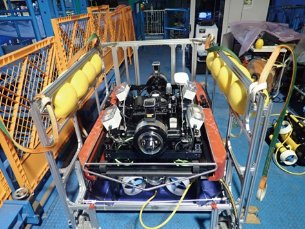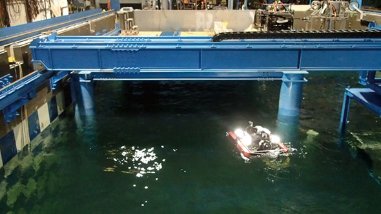Major Research 2B Research on Life Cycle Management of Infrastructures
Background and Objectives
The ports, airports and coastal infrastructures that have been in service for a long time are increasing, but financial resources and the number of engineers for facility maintenance are limited. As important port, airport, and coastal infrastructure functions should be maintained, the strategic maintenance, renewal, and other measures to maintain such functions are strongly required.
Therefore, we are trying to establish methods for structure design and material selection which are excellent in terms of maintenance, and will develop techniques and technologies regarding various countermeasures for maintenance phase.
Research Topics
Research and development comprises the following three subthemes:
- Research on technologies for prolonging the life of infrastructure
Regarding various construction materials in marine environments, we will conduct research on the following: evaluation of long-term durability, understanding of deterioration mechanisms, and investigation of the prevention effects of protective methods for steel structures. Especially, assuming that infrastructure is used overseas and on remote islands in Japan, we will investigate material characteristics for durability improvement under severe environments and under conditions in which low-quality material is used, and will investigate environmental-load reduction, durability improvement, and environmental harmonization. Regarding airport pavement, we will investigate methods for detecting the stripping of asphalt mixtures, measures to prevent such stripping, how the durability performance of airport pavement can be improved, and quick repair and rehabilitation techniques while construction quality, is still assured. - Research on systems for inspecting and diagnosing infrastructure
We will conduct R&D on inspection and diagnosis techniques that utilize non-destructive and semi-destructive inspection methods and sensors, and unmanned investigation devices including ROVs. We will also study operation methods for inspection and diagnostic systems, etc. that leverage robots, drones, and other novel technology. Especially, we will propose a health monitoring system that utilizes sensors and also an efficient inspection and diagnosis method specific to each component and material type, and will also study efficient data analysis methods.
In addition, for piers, we will establish a scheme for selecting inspection and diagnosing methods according to the performance of structures to be evaluated and the accuracy of expected output. - Research on maintenance and management systems for infrastructure
We will conduct accelerated deterioration tests of members of port structures, investigate performance deterioration models which cover the entire lifecycle of structures, and validate such models through exposure tests in actual environments and through on-site investigation. We will also take into account the required properties and utilization of individual structures, budgets, and various limitations, and then suggest strategies of management of port-based and district-based groups of port structures.
Activities in FY 2019
We used long-term exposure facilities to study how to predict chloride-induced concrete deterioration, the electrolytic protection characteristics of steel bars in reinforced concrete, and the concentrated corrosion mechanism that affects steel materials. We also obtained data on the durability of various wood materials and reinforced concrete that utilized recycled aggregate.
We aimed to establish a method for predicting the deterioration of protective coating methods against corrosion. To achieve this goal, we conducted continuous experiments at Hazaki Oceanographical Research Station, including exposure tests on steel pipe piles to which anti-corrosion protective coating had been applied, and also on hat-shaped sheet piles. We also conducted accelerated aging tests and exposure tests to further elucidate the deterioration mechanism of petrolatum coating methods.
We evaluated the durability of concrete, in which low-grade aggregate (coral aggregate) and seawater as mixing water had been used, and conducted exposure tests to develop a concrete-curing technique using seawater. We also evaluated the durability of highly corrosion-resistant reinforcing steel and surface coating materials through exposure testing.
To study the effects of steel wire mesh in airfield concrete pavements, we reviewed documents about the effects of steel wire mesh, the quantities in which it may be applied, available joint spacing variations, etc., and also conducted indoor experiments, etc.
We studied the workability of the filling material solidification method for reinforcing existing caissons, and how their load-bearing and impact-resistant capacities would be affected by the improved strength and the scope of improvement. Also, to enhance the technique for repairing prestressed concrete components, we studied how their durability would be compromised by chloride-induced corrosion, and how their structural characteristics might be affected by repairs. We then systematically organized our findings on those elemental technologies, and proposed a design workflow (draft) for repairing and reinforcing concrete structures. In addition, we conducted experiments on the expansion caused by delayed ettringite formation, and studied and evaluated how it would be affected by water-shielding repair and restraining reinforcement methods.
We conducted verification tests on monitoring by the inspection and diagnosis system using IoT in addition, we studied the feasibility of performing inspections using underwater drones and examined how such inspection method could be operated.
We conducted experiments on ROVs for inspecting the superstructures of piers, and observed how their position measurement would be affected by waves and other external disturbances. In addition, we conducted on-site surveys using the ROVs while taking into account the waves and other site-specific conditions.
To advance the process of formulating preventive maintenance plans for port and harbor facilities, we performed case studies on model piled piers, while formulating renovation scenarios (selection of an optimal renovation method and timing) based on which those piled piers can be converted into a preventive maintenance, using LCC, NPV, and LCCO2 as evaluation indicators.


ROV for inspecting pier superstructures and its experiment in a water tank
(with wave and current)



